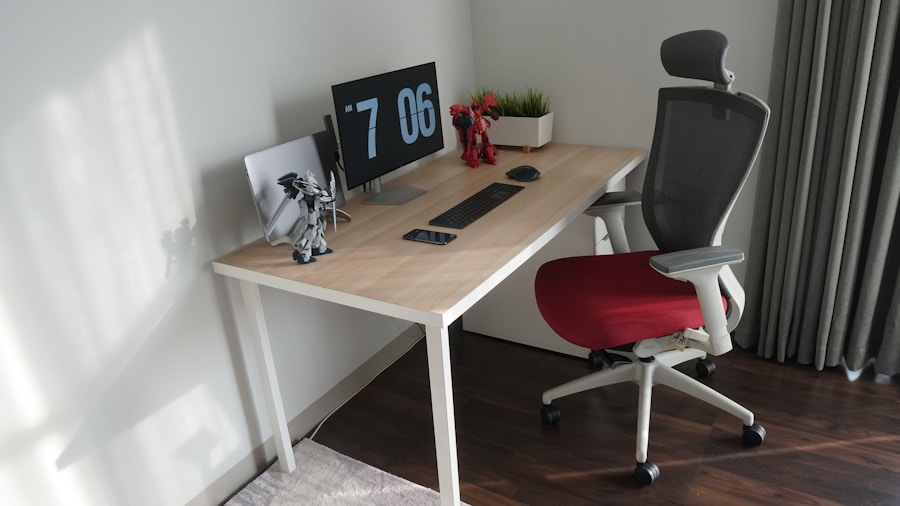In recent years, the debate surrounding standing and sitting desks has gained significant traction, particularly as more individuals become aware of the health implications associated with prolonged sitting. The traditional office setup, characterized by a static sitting position for hours on end, has been scrutinized for its potential to contribute to a range of health issues, including obesity, cardiovascular disease, and musculoskeletal disorders. In response to these concerns, standing desks have emerged as a popular alternative, offering a dynamic approach to work that encourages movement and engagement.
This shift in workplace ergonomics has sparked interest not only among employees but also among employers seeking to enhance productivity and well-being in the workplace. The evolution of desk design reflects broader changes in our understanding of health and productivity. While standing desks are often lauded for their potential benefits, sitting desks remain a staple in many work environments.
The challenge lies in finding a balance between the two, allowing individuals to tailor their workspaces to their personal preferences and needs. This article delves into the advantages and disadvantages of both standing and sitting desks, providing insights into how to effectively incorporate them into daily routines and maximize productivity.
Key Takeaways
- Standing desks can help reduce the negative health effects of prolonged sitting and promote better posture and movement throughout the workday.
- Standing desks can help increase energy levels, improve mood, and boost productivity by reducing sedentary behavior.
- Sitting desks provide comfort and support for tasks that require focus and concentration, and can be beneficial for individuals with certain health conditions.
- Incorporating both standing and sitting desks into your workday can help reduce the risk of musculoskeletal issues and improve overall well-being.
- To use standing and sitting desks effectively, it’s important to alternate between sitting and standing, adjust desk height to maintain proper ergonomics, and take regular breaks for movement and stretching.
The Benefits of Standing Desks
Reducing Sedentary Behavior
Research suggests that prolonged sitting can lead to various health issues, including an increased risk of type 2 diabetes. By using a standing desk, individuals can significantly decrease the amount of time spent in a sedentary position, which may contribute to improved metabolic health.
Boosting Energy and Productivity
Many users report feeling more alert and focused when working while standing. This heightened sense of engagement can lead to increased productivity, as individuals may find it easier to concentrate on tasks without the lethargy that often accompanies extended periods of sitting.
Improving Posture and Reducing Discomfort
Standing desks can facilitate better posture, reducing the risk of developing musculoskeletal issues such as back pain and neck strain. By encouraging a more natural alignment of the spine, standing desks can help alleviate discomfort associated with poor posture.
The Benefits of Sitting Desks

Despite the growing popularity of standing desks, sitting desks continue to hold their ground in many workplaces due to their own set of advantages. One of the primary benefits of sitting desks is comfort. For tasks that require prolonged focus or fine motor skills, such as typing or detailed design work, sitting can provide a stable and comfortable position that allows for greater concentration.
Many individuals find it easier to maintain their focus when seated, as they can adjust their chair and desk height to achieve optimal ergonomics. Additionally, sitting desks can be more conducive to certain collaborative activities. In environments where teamwork and discussion are essential, seated arrangements can foster a sense of camaraderie and facilitate communication.
The relaxed posture associated with sitting can create a more informal atmosphere, encouraging open dialogue among team members. Furthermore, for those with specific health conditions or physical limitations, sitting desks may be necessary for maintaining comfort and preventing fatigue.
How to Incorporate Standing and Sitting Desks into Your Workday
Integrating both standing and sitting desks into your workday requires thoughtful planning and an understanding of your personal work habits. One effective approach is to adopt a hybrid model that allows for flexibility throughout the day. For instance, you might start your morning at a sitting desk while reviewing emails or engaging in tasks that require deep concentration.
As the day progresses and energy levels fluctuate, transitioning to a standing desk for meetings or brainstorming sessions can provide a refreshing change of pace. Establishing a schedule that alternates between sitting and standing can also be beneficial. Many experts recommend following the 20-8-2 rule: for every 30 minutes spent working, aim to sit for 20 minutes, stand for 8 minutes, and move around for 2 minutes.
This approach not only helps break up long periods of inactivity but also encourages movement throughout the day. Incorporating short walks or stretches during breaks can further enhance circulation and reduce muscle tension.
Tips for Using Standing and Sitting Desks Effectively
To maximize the benefits of both standing and sitting desks, it is essential to adopt proper ergonomics and make adjustments based on individual needs. When using a standing desk, ensure that your monitor is at eye level to prevent neck strain and that your wrists are straight while typing. A footrest can also be helpful for shifting weight from one leg to another, promoting comfort during extended periods of standing.
For those utilizing sitting desks, investing in an ergonomic chair is crucial. Look for chairs that provide adequate lumbar support and allow for adjustments in height and tilt. Your feet should rest flat on the ground or on a footrest while your knees are at a 90-degree angle.
Additionally, consider using a sit-stand converter that allows you to easily switch between sitting and standing positions without needing to invest in an entirely new desk.
Choosing the Right Standing and Sitting Desk for Your Needs

Selecting the appropriate desk is vital for ensuring comfort and productivity in your workspace. When considering a standing desk, look for models that offer adjustable height settings, allowing you to customize the desk to your preferred standing position. Some advanced models even come with programmable settings that enable users to save their preferred heights for quick adjustments throughout the day.
For sitting desks, prioritize stability and adjustability. A desk with a wide range of height options will accommodate various body types and preferences. Additionally, consider the surface area; ample space is necessary for placing monitors, keyboards, and other essential tools without feeling cramped.
If you frequently collaborate with colleagues or engage in group discussions, opting for a larger desk may facilitate teamwork while providing enough room for multiple users.
Common Misconceptions about Standing and Sitting Desks
Despite the growing body of research supporting the benefits of both standing and sitting desks, several misconceptions persist regarding their use. One common myth is that standing desks are inherently better than sitting desks for everyone. While standing desks offer numerous advantages, they are not a one-size-fits-all solution.
Some individuals may experience discomfort or fatigue when standing for extended periods, making it essential to listen to one’s body and find a balance that works best. Another misconception is that using a standing desk eliminates all health risks associated with sedentary behavior. While standing more often can reduce some risks associated with prolonged sitting, it does not negate the importance of regular movement throughout the day.
Engaging in physical activity beyond simply alternating between sitting and standing is crucial for overall health. Incorporating walking breaks or stretching exercises into your routine remains essential regardless of your desk choice.
Maximizing Productivity with Standing and Sitting Desks
The integration of standing and sitting desks into modern work environments reflects an evolving understanding of health, productivity, and ergonomics. By recognizing the unique benefits each type of desk offers, individuals can create personalized workspaces that cater to their specific needs and preferences. Whether opting for a hybrid approach or choosing one style over another, the key lies in maintaining flexibility and prioritizing comfort.
Ultimately, maximizing productivity involves more than just selecting the right desk; it requires an awareness of how our bodies respond to different work environments. By adopting effective strategies for incorporating movement into our daily routines and understanding our own ergonomic needs, we can create healthier workplaces that foster both well-being and efficiency.
Standing and sitting desks have become increasingly popular in modern office design as companies prioritize employee health and productivity. According to a recent article on officeinterior.ae.
FAQs
What are standing and sitting desks?
Standing desks are desks that are designed to be used while standing, allowing the user to work in a standing position. Sitting desks are traditional desks that are designed for use while sitting in a chair.
What are the benefits of using a standing desk?
Using a standing desk can help reduce the risk of weight gain, lower blood sugar levels, reduce the risk of heart disease, and improve mood and energy levels.
What are the benefits of using a sitting desk?
Sitting desks provide a comfortable and stable work surface for tasks that require sitting, such as writing, typing, and reading.
Are there any drawbacks to using a standing desk?
Some people may experience discomfort or fatigue from standing for long periods of time. It’s important to use an anti-fatigue mat and wear supportive footwear when using a standing desk.
Are there any drawbacks to using a sitting desk?
Prolonged sitting can lead to health issues such as obesity, diabetes, and cardiovascular disease. It’s important to take regular breaks and incorporate movement into your day when using a sitting desk.
Can I switch between standing and sitting at a desk?
Yes, many desks are designed to be adjustable, allowing users to easily switch between standing and sitting positions throughout the day.
Are there any ergonomic considerations for using standing and sitting desks?
It’s important to ensure that the desk and chair are at the correct height to promote good posture and reduce strain on the body. Using a footrest and monitor riser can also help maintain proper ergonomics when using a standing or sitting desk.


